The Great Grapevine Road Fight, Part I
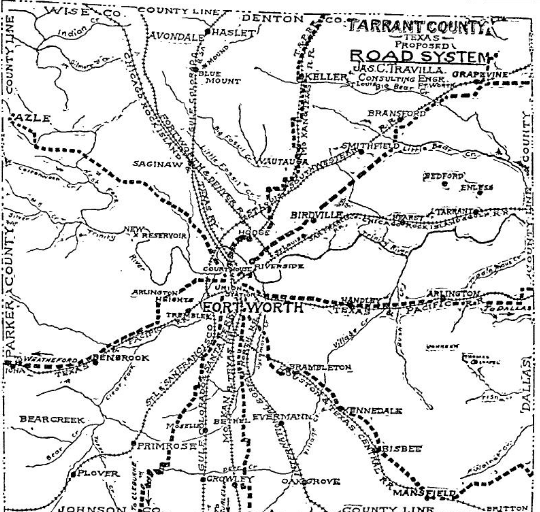
In today’s blog post we begin the colorful history of the road connecting Fort Worth to Grapevine in the latter part of the 19th century that went by several names, including Grapevine-to-Fort Worth Cardinal (main) Road, Cardinal Road, Grapevine Pike, Fort Worth-to-Grapevine Road, and eventually, State Highway 121. By whatever name it was called, the road to its completion was far from smooth.
Although Grapevine’s growth as a town included the development of its internal infrastructure, the transportation network beyond the township limits remained a significant problem throughout much of the historic period. Finally in 1884 a commission was appointed in Fort Worth to establish the alignment of four main (cardinal) roads in Tarrant County heading north, south, east, and west from Fort Worth. One of the results of the commission’s planning activities was the construction of the sub-cardinal Grapevine Road running northeast from Fort Worth. A sub-cardinal road is a road located halfway between each pair of cardinal directions. Built from Fort Worth to Grapevine, it stopped short of the township by eleven miles, ending abruptly at a place called Anderson’s Corner. The terminus was reputed have been the result of high land prices and a general opposition from farmers who prevented the road’s construction through their fields. Little improvement of this condition would occur until the early 20th century, when a series of bond elections were approved for the extension of the highway into Grapevine.
“The road between here and Fort Worth is in a wretched condition”
The main thoroughfare from Fort Worth to Grapevine began as a rutted narrow wagon dirt path that snaked through almost every farmstead along the way. In late April 1884, the Tarrant County Commissioners Court ordered that a jury of view be appointed with the county surveyor to lay out, mark, and establish several first-class roads, including one from Fort Worth to Grapevine and McKinney. (A jury of view consisted of five disinterested property owners who held a public hearing, examined evidence, and issued a report on whether a road was a county road.) That same month, the Grapevine Telephone newspaper strongly endorsed this action and editorialized that “[a] first-class turnpike road from Fort Worth to Grapevine would do lots of good.”
By June 1885 Tarrant County commissioners began to realize the value of organizing and carrying through a public road system that would give access to Fort Worth from all parts of the county. A recent survey made by the Commissioner’s Court jury commission revealed that the distance between Fort Worth and Grapevine could be reduced from twenty-eight and one-half miles to nineteen miles on a straight road. A farmer with a loaded team traveling to Fort Worth at three miles per hour could save nineteen miles on each round trip, thus saving over six hours of time as well as wear and tear on his wagon and team. In July the Grapevine Telephone expressed the urgent need for good roads in very plain terms (see Figure 1):
Our county roads are almost impassable. The road between here and Fort Worth is in a wretched condition. The crossing at Bear creek is badly washed and the road on both sides of the creek would be considered a first-class gully if it wasn’t known that that was the post route . . . Can’t our commissioners give us better roads and a few bridges? They are needed, and badly, too.
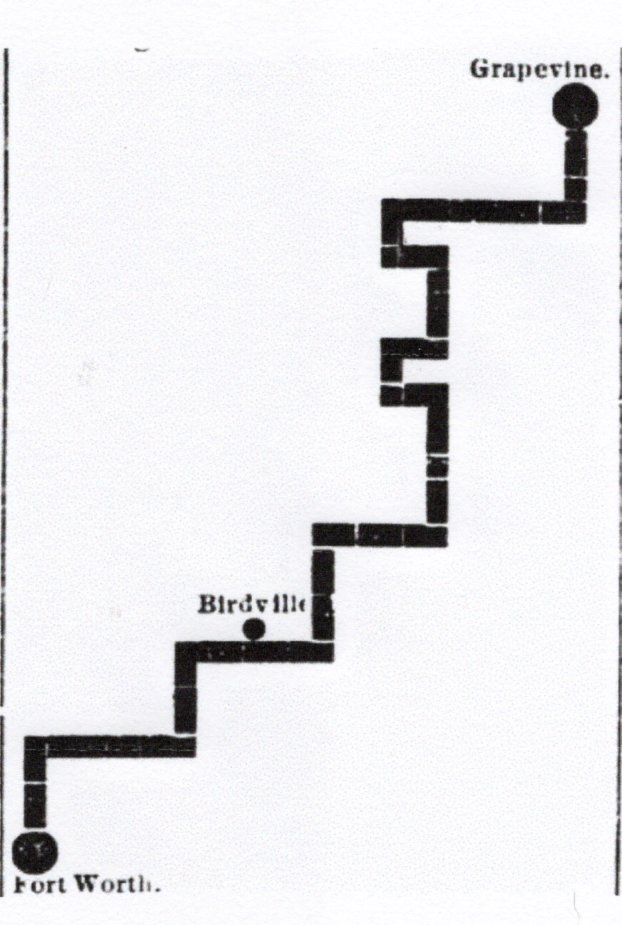
Worth-Grapevine Road, Grapevine
Telephone, May 20, 1887, p. 4.
By September 1885, actual work had still not been done beyond the surveys. The Fort Worth Gazette pointed out at the time that even though surveys for four county cardinal roads were made at a cost of $4,000, the commissioners had kept postponing action. By May 1886, several petitions regarding roads and bridges had been presented to the commissioners, and in February 1887 they appointed a five-man jury of view on the direct road from Fort Worth to Grapevine, which would be a dirt road. The jury affirmed that even though the state had the right of eminent domain, just compensation would have to be given to farmers whose lands would be substantially impacted by the new road. They also believed there would not be much resistance to securing the state’s right of way.
On June 13, 1887, the county commissioners met solely to consider the question of establishing a straight road from Fort Worth to Grapevine and the many benefits to be derived from it. They took no direct action, but the jury of view recommended the original straight survey as cheaper and preferable to subsequent surveys, allowing property owners along the route to be awarded damages of $7,031. The commission postponed further action until July 12 when the jury of view could make a more comprehensive report.
Controversy and Dissent
On July 10, however, a story appeared in the Fort Worth Gazette wherein one member of the jury of view claimed that Dallas and Grapevine merchants were in league to prevent county road building, but he did not think the opposition would amount to much. Nevertheless, he stated that Grapevine merchants garnered petitions from renters in the vicinity who were indebted to them, the merchants saying that they wanted the distance to Fort Worth lengthened instead of shortened because as the merchants bought their goods in Dallas, as it would be in their interest to keep people away from Fort Worth. Additionally, they claimed Dallas was making “profuse promises” about building roads to Fort Worth and that work had already begun on a dirt road to that city from Dallas. This jury member felt that such a protest from Grapevine could stop work on the Fort Worth-Grapevine Road, but that the benefits of the entire road would prove so great that this opposition would soon be overcome.
This article, in the form of an interview, came into the hands of Mr. Will B. Davis of Grapevine, who insisted that the statements made by the anonymous member of the jury of view were “false in the main and in detail” and reflected negatively on Grapevine merchants and farmers. Mr. Davis asserted that the only reason these men signed the petition, which was circulated by farmer “Uncle Billie Johnson” who lived three miles from Grapevine, was that they were in favor of the new road but were simply assisting their long-time neighbors out of friendship. The initial petitioning farmers claimed that a road to Grapevine would cut most of their farms diagonally across, creating “inconvenient shapes.” As far as a Grapevine-Dallas conspiracy was concerned, Mr. Davis reiterated that Grapevine merchants welcomed and wanted business with both Dallas and Fort Worth. Shortly thereafter, the Tarrant County Banner came out in support of Mr. Davis’s response.
At the July 12 meeting the straight road was ordered opened up as far as Bransford (now Colleyville) and the commissioners decided to meet on August 10 to hear claims for damages by a crowd of property owners. Work would extend only as far as A. J. Anderson’s corner near Bransford because land prices were high (seven dollars an acre) and farmers in the vicinity did not want their places ruined. After the hearing, the commissioners’ vote ended in a tie, so the judge’s tie-breaking vote resulted in the decision not to proceed with the road. A member voting against the measure explained that he wanted the road, but he believed the county could not afford the expenses involved in building it, including $5,400 in compensating farmers, clearing timber, and the cost of graveling two to three miles of heavy sand. A disappointed member voting in favor observed that clearly the road was needed and the majority of farmers wanted it. “It runs through the most populous part of the county,” he emphasized, “and is traveled more than any other highway.” He claimed the proposed change would also have shortened the route, thus reducing expenses, and pessimistically posited that the vote “has killed the straight road for all time.”
In spite of the commissioners’ rejection, strong positive attitudes toward that road still circulated. A week after the commission’s decision, the Fort Worth Gazette implied that “certain local interests” would benefit by not having straight county roads. It also insinuated that the August meeting was significant only to those who expected to demand “extravagant prices” from Tarrant County in return for granting it the right of way. Still, the paper predicted that “good sense and liberality of the people” of Tarrant County would eventually prevail. In December 1887, the Fort Worth Weekly Gazette observed that a good macadamized road (a road paved with small consolidated broken stone; see Figure 2) to Grapevine would pay for itself because of the greater volume of outside travel over time.

At the end of January 1888, another jury of view tasked with assessing the damages resulting from the straightening of the Fort Worth-Grapevine road reported that $5,869.85 should be paid to farmers whose lands would be taken by eminent domain, and at the commission meeting on February 15, 1888, the straight road between Fort Worth and Bransford was approved. The Fort Worth Daily Gazette reported that several farmers along the road were generous in granting the right of way and averred that work should begin immediately since the northeastern part of Tarrant County was the most densely populated and more people traveled it than any other road in the county. By the end of August 1889 about a mile and a half of the Fort Worth-Grapevine Road had been graded and was quickly being graveled. Newspapers as far south as San Antonio took note. On January 27, 1890, the San Antonio Daily Light reported that “[e]verybody at Grapevine wants good county roads.” The Grapevine Post followed suit on March 16, stating that “[g]ood roads bring a thrifty immigration into the county, build up towns, schools[,] and churches.”
The Battle Continues
Twenty years later, in 1909, the good roads issue reared its head once again. Many county residents believed that current roads were not in good condition at that time and that business was being lost to Dallas, which had been spending thousands of dollars on building and maintaining a better road network. A movement looking toward concerted action of all interested organizations and individuals on behalf of better Tarrant County roads was begun by the Fort Worth Board of Trade. Representatives of the Board, the Grapevine and Arlington Commercial Clubs, and Mansfield business interests met in Fort Worth on May 5 to formulate policy and establish the Tarrant County Good Roads Association, with Arlington postmaster J. I. Carter as president. Representing Grapevine at the convention were W. H. Lucas, W. A. Trembly, H. F. Saunders, J. P. Schultz, and B. R. Wall. The idea was for every Tarrant County town to have a local good roads club in every justice of the peace precinct. B. R. Wall was elected as one of four vice-presidents and W. H. Lucas was elected secretary.
At a meeting on May 20, the Association proposed a one-million-dollar bond issue. A committee was appointed to draft a petition asking the County Commissioner for issuance of these bonds for permanent improvement of Tarrant County roads. Bonds would be payable after forty years for permanent road work. After the issuance was granted, July 17 was set for a county-wide vote. Schoolhouse meetings were scheduled across the county to spread the gospel of good roads. Grapevine citizens met at the Grapevine Commercial Club rooms on June 18 to hear about the benefits of good roads and the lower road tax to be imposed if the bond issue passed, but not all were convinced; in fact it was a bona fide hot potato. On July 9, the Tarrant County Farmers’ Union in Fort Worth drafted a resolution urging farmers to vote against the measure because they opposed the use of automobiles on country roads. Union officers included Grapevine residents W. R. Buckner, President; E. E. Higgins, Vice President; George M. Barager, Secretary-Treasurer; state delegate and alternate, W. R. Buckner, and R. A. Turner. The Fort Worth Record and Register described Mr. Barager was described as “a dyed-in-the-wool Farmers union man.” A final meeting was held at the annual picnic of the “old union local” of the Farmers’ Union on July 16, with speakers urging members to vote for or against the bond issue.
Grapevine interest in the subject was so keen that on voting day, the Grapevine Sun printed four notices, two urging eligible citizens to “vote your sentiments like a man” and show up at the polls, one urging a vote against the bond because “we don’t need it,” and a fourth that combined the sentiments of the first three. In spite of the Good Roads Association’s efforts, however, the bond issue was overwhelmingly defeated, losing by a vote of three to one. At Grapevine, only nine voted in favor, while 180 (mostly farmers) said no. Bransford voted sixty-five against and no one in favor. J. I. Carter, president of the Association, charged that the opposition’s “demagoguery and fifteen percent of automobile users” contributed to the defeat. He claimed that opponents convinced farmers that they would be overtaxed. Farmers also believed that more automobiles on improved roads would be hazardous to their wagons and horses. In fact, many voters who favored the bonds stayed home because they believed the measure was “foredoomed to defeat.” In spite of the loss, proponents vowed to continue the fight.
The Road Issue Is Resurrected . . . Again
Like a phoenix rising from the ashes, the good roads initiative was revived on September 14, 1911, when citizens from all over Tarrant County met to discuss a proposed $1,600,000 road and bridge bond issue and petition for an election. Though not present, B. R. Wall of Grapevine communicated to J. I. Carter that his community would conditionally back up any project that was shown to be beneficial, even though he was personally against the idea. He was not alone. In fact, so many Grapevine voters were unconvinced of the benefits and so strongly opposed that the Star-Telegram asserted that “real live missionary work” needed to be done there if the measure was to have any chance of passing.
The Fort Worth Star-Telegram reported on September 21 that a great majority of Grapevine residents were happy with the condition of their roads and their ability to get their goods to market in Fort Worth. Others felt that Arlington and Fort Worth would get most of the road funds, and some wanted such funds to be used for all roads, not just the main thoroughfares. Several well-known citizens were interviewed and responded thusly:
- H. R. Wall believed the current roads were not wide enough, and that what helped Fort Worth would help all of Tarrant County.
- J. L. Byas, who had lived in Grapevine for fifty years, had a farm on the Fort Worth-Grapevine Road and favored the bonds. He had previously tried and failed to get the county to improve the road by widening it to sixty feet.
- M. W. Lucas favored passage because of the effects of Dallas County’s good graveled roads.
- Drs. T. B. Dorris, R. S. Lipscomb, and dentist O. O. Hollingsworth favored the bonds because they traveled roads frequently.
- Pharmacist J. P. Schultz favored passage.
- R. E. Morrow, president of Grapevine National Bank, said that taxes were already too high.
- B. R. Wall thought the million was excessive, and that the proposition “looked more like a contractors’ and engineers’ deal than anything else.” He also wanted the Fort Worth Streetcar Company to pay its share of the bridge construction because the bridges would be built in Fort Worth.
- E. V. Dunn doubted that such funds would be handled well and was against it.
- J. E. M. Yates, dry goods store owner and president of Farmers National Bank was against the bonds but in favor of fixing the roads.
- C. C. Estill, lumberman and property holder, also had doubts about apportionment.
- M. A. Buchanan opposed the issue due to likely tax increases.
- A. L. Ingram also expected tax increases and opposed the measure.
- C. E. Stewart was amenable if funds distribution was equitable.
- M. J. Michaels, like B. R. Wall, was in favor only if each road got a fair share of the funds and that the Fort Worth Streetcar Company pay its share of the bridge construction.
On September 30, county representatives from every precinct who originally met on September 14 met again and agreed unanimously that bonds should be issued and money should be distributed fairly by the County Commissioner, the latter move likely satisfying some critics. Representatives from the country were asked to come up with any method they saw fit to secure their interests. Grapevine was again represented by H. R. Wall, H. F. Saunders, and J. E. Betts, who believed that after explaining the situation to the voters, the community would approve the bond measure. H. F. Saunders had been on the fence over the bond issue, but after the discussion he was satisfied and willing to help convince his neighbors of its benefits.
In a letter to the Fort Worth Record and Register on October 3, R. F. Jones, an ex-Justice of the Peace in Grapevine, objected vigorously to road bonds, going so far as to say that debt caused the downfall of the Roman Empire and would also cause unbearable tax burdens on Grapevine farmers whose crops may or may not carry them over another year due to weather conditions. He also argued that “anyone with horse sense knows these autos and motorcycles are two [sic] dangerous to run over the public highways out in the country. They are disturbers of the peace” and “will cause your team to run away and may be [sic] kill or hurt you for life.” Interestingly, in that same issue, representatives from Grapevine said that support was rapidly growing. Grapevine mayor B. H. Yancy, who, like many in his community, strongly opposed the issue, posited that the measure would carry in that section by a small majority. During the run-up to the actual election on December 12, 1911, Fort Worth newspapers repeatedly extolled the benefits of good roads to all Tarrant County merchants.
In the good roads conference in early November, Dr. T. B. Dorris, B. P. Payne, Lon Ingram, J. T. Yancey, and J. C. Koonce from Grapevine were appointed to the Good Roads Campaign Committee, as well as A. B. Shivers of Bransford. On November 7, J. E. Betts was elected chairman for Commissioner’s Precinct No. 3 to conduct the good roads campaign in that area by distributing literature and holding meetings. The conference also resolved that due to taxpayer demand, that roads and bridges should be constructed with local labor. In late November, the local carpenters’ union voted to cooperate with other labor organizations and work with the farmers on the road project. Judge George Thompson and W. P. McLean, Jr. were appointed to speak at Grapevine on December 2, emphasizing the savings in transportation that comes from good roads, and were well received.
For all the effort that went into persuading Grapevine to vote for the road bond issue, its voters rejected the measure 158 to fifty-six, but it passed in Tarrant County overall by a very small margin of 400 votes. The Grapevine Road would be macadamized, making it the first all-weather road to serve the area. In February 1912, Dr. T. B. Dorris and B. R. Wall were appointed to the Good Roads Advisory Committee. Wall, a member of the Grapevine Commercial Club, reminded his neighbors that even though they had voted down the road bond issue, the Commissioners’ Court had the legal right to work roads in an unincorporated city such as Grapevine whose population was more than 200 but less than 10,000. Grapevine had 700-800 residents in 1912.
The final action in Tarrant County’s road and bridge bond sale was taken on March 16, 1912 when the contract between the bonding company, purchasers, and the county was signed by the commissioners, and plans could now be taken up for the road system. The first bond money became available in mid-April 1912. After the bridge and road bonds were transferred in early May 1912, the Grapevine Road was one of six heavily traveled roads to get the attention of Tarrant County Engineer H. P. Hayes. By mid-June the Fort Worth-Grapevine Road had been surveyed.
Trouble Ahead?
By August 1, however, the good roads project had hit a snag. Commissioner R. E. Duringer of Precinct 1 filed an injunction against the other commissioners, charging violations of the road building procedures they had initially agreed to carry out. He claimed that funds intended to build permanent cardinal and sub-cardinal roads in the macadam fashion in Precinct 3 (Grapevine section) were instead being used for a clay and sand bed instead, and that expenditures beyond that precinct’s allotment were being made from the general fund. He also said there was no qualified engineer to make plans and specifications, and there was no supervisor in each precinct to make sure supplies were adequate for the job. Judge W. R. Booth, representing the County Attorney’s office in civil matters, requested an injunction halting expenditures of bond money until the presiding judge made a ruling.
On August 17, 300 citizens from the Grapevine community endorsed Wallace Estill, their county commissioner, for his handling of Precinct 3’s bond money. Representatives from every voting box in the precinct attended, and approving resolutions were adopted. Grapevine Mayor B. R. Wall stated that the residents wanted gravel and dirt roads rather than macadam crushed rock or rock ballast roads because they believed they would get more for their money. A committee from each voting box was appointed to attend a hearing on the injunction on August 19. Precinct 3 residents believed that Fort Worth was not treating them right and would fight Commissioner Duringer’s charges. Farmers in the areas where the roads were going in were performing the roadwork with wagons and teams they purchased, and then having to wait to have their work checked. But since roadwork had been halted, their payments on the wagons and teams would also have to stop, and they would be out of work until cotton picking time. Once cotton picking commenced, those farmers would have no time for roadwork. This situation caused them much suffering and not a little inconvenience.
The meeting to discuss the proper method for spending what was left of the bond money was held on August 19 at the Fort Worth Chamber of Commerce, where citizens from Precincts 2, 3, and 4 appeared. J. H. Davis of Grapevine asserted that the intent of this meeting was to protest the injunction and try to work out an agreement amenable to the county commissioners regarding expenditures on the road bond issue fund on August 24. Davis and B. R. Wall, prominent members of the Precinct 3 delegation, met with Commissioners Estill, Rogers, and Reeves. The Grapevine delegation also drew up and circulated a petition at the courthouse to be presented at the meeting, backing up the commissioners and asserting that residents were happy with their dirt and gravel roads, which they believed suited them best. No matter how many delegates attended, each precinct was allowed only two votes. Grapevine resident Clarence Stewart, who believed it was an honor to serve because the convention had “momentous importance,” was named chairman of the resolutions committee for this meeting and pleaded for cool and deliberate judgement in the proceedings.
Despite this, the atmosphere was intense. Many people on each side of the issue kept trying to speak at once, distrusting what opponents were saying. A Reverend Scott, delegate from Smithfield, was called upon to ask for a divine blessing and remind everyone to work in a spirit of unselfish cooperation. Once everyone calmed down, a committee was appointed with one delegate from each precinct which would handle all resolutions, with Clarence Stewart representing Precinct 3. Grapevine citizens were expected to fight the hardest against Commissioner Duringer’s contentions, opposing any kind of compromise. They would also demand an equal division of the bond money, regardless of proportionate tax payments.
Contrary to initial beliefs, a compromise was reached. The convention affirmed the four commissioners’ decisions. A conference with the commissioners was held on August 28, and ended with the compromise that the commissioners must map out a plan, then work out the plan based on specifications submitted by the engineer showing the location of each road and its estimated cost when built of gravel or another material the commissioners chose. The commissioners would decide which material was to be used. Each precinct would have a road engineer and road supervisor. Work already begun could proceed to completion; Dick Wiggins and B. R. Wall of Grapevine had testified that the roads under construction in Grapevine suited them. Duringer’s pleas for use of crushed rock instead of gravel and the use of contract labor were denied. Judge R. H. Buck of the Forty-Eighth District Court affirmed that as long as the commissioners were properly conducting the road building process, Duringer’s suit would be dismissed and would not go to court. Judge Buck also decreed that $400,000 of the million-dollar bond money must be equally distributed among the four precincts for lateral (feeder) roads.
Road Work Finally Begins
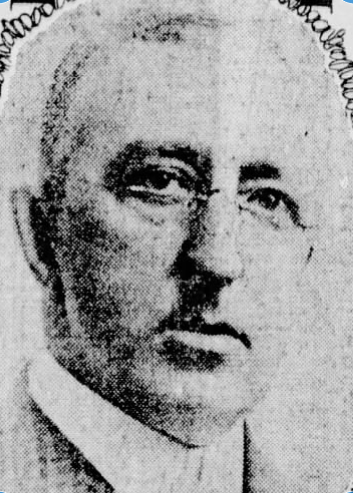
was responsible for
supervising the improvement
of Tarrant County’s road
system.
Road construction throughout Tarrant County began in March 1913 when James C. Travilla, formerly the highway engineer in St. Louis, Missouri (Figure 3) became the supervising engineer over construction intended to improve Tarrant County’s road system. The sub-cardinal Grapevine Road was the longest at 24.28 miles; its cost was $171,130, averaging $7,048 per mile. Its length necessitated that it be divided into two sections. Section A was 11.3 miles long, and Section B was in Precinct 3 and was 12.56 miles long. Work began on this road on May 20, about one-quarter of a mile from Birdville, with a large number of citizens present. Brief speeches were given by Engineer Travilla, Commissioners Sandy Wall of Precinct 3 and W. O. Reeves of Precinct 4, and were responded to by Mayor B. R. Wall, Dr. W. H. Davis, Henry Sanders, and C. E. Stewart, all of Grapevine. Resident Joe Lucas tried his hand at plowing after Reeves first broke ground. Engineer Travilla, seriously considered some citizens’ belief that this asphalt-macadam road should be straightened at many points along the route; it would perhaps be the longest such stretch of pike in Texas. Travilla’s contract called for Section A to be completed in 250 working days and Section B in 268 days.
In early June 20 men and teams from San Angelo arrived and set up camp near Grapevine where they soon started grading and scarifying the Grapevine Road from Grapevine towards Fort Worth. The Grapevine Sun reported on September 27, 1913 that good progress on the road was being made. Recent rains made the base of the road in good condition for the rock, where the gravel base had been completed. By the end of October, Commissioner H. R. Wall of Precinct 3 chose thirteen men from that precinct to captain thirteen companies of road workers. These men would supervise over one hundred laborers from Fort Worth. Seven of the thirteen captains were from Grapevine; the rest were from Tarrant, Bedford, Bransford, White’s Chapel, and Hurst. Early December floods did little damage to Grapevine area roads.
The Grapevine Road was not the only road where improvements in Precinct 3 were taking place. In mid-January 1914 the county commissioner approved estimates for graveling 645 feet of Grapevine’s Main Street at a cost of $183.75, which would be paid out of the country road fund because Grapevine was not incorporated. Bids were then immediately opened.
On January 14, Tarrant County commissioners appointed several delegates to attend the Good Roads Association meeting in Fort Worth from January 26-28, one of whom was Dr. O. O. Hollingsworth of Grapevine. Twenty-five farmers who finished winter plowing and had little to do put teams to work on the Grapevine Road during the second half of January, since using local labor was a condition for conducting road work. Engineer Travilla stated at the beginning of April that two crews were at work every day on the Grapevine Road between the Dallas County line and Grapevine, and the road would be completed within three weeks. Most of the work on this road was centered on the stretch between Birdville and Grapevine. In mid-May, the date was pushed back to August 1 due to less work being done on it because of heavy rains, but in early August it was again pushed back, this time to early September. Travilla reassured Grapevine residents on July 18 that they were not forgotten; work was also delayed by problems with getting stone chips to cover oiling on the road but he expected to start oiling within two weeks.

Fort Worth Record-Telegram, October 6, 1914, p. 8.
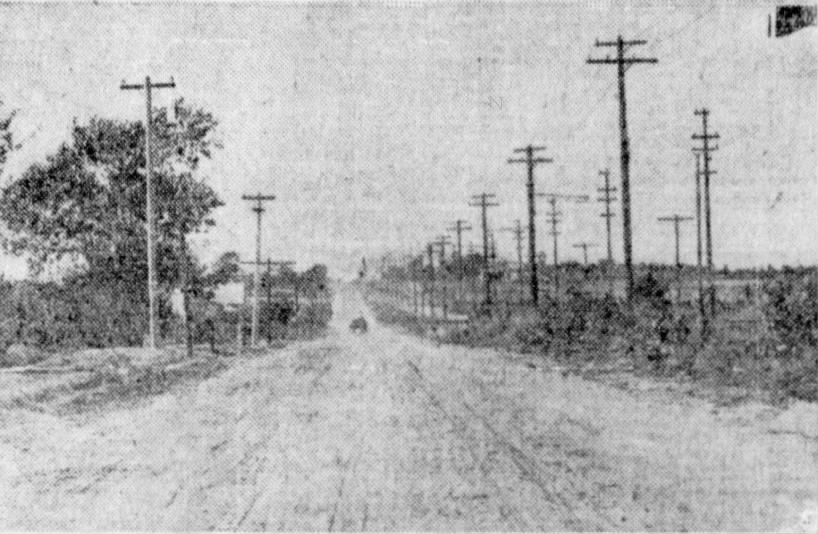
Section B of the Grapevine Road was practically completed by September 9, 1914. All of the stone was on and some oiling had been done. In early October, Engineer Travilla said he was especially proud of a portion of the Grapevine Road leading to the Dallas County line because he disproved the belief that such roads could not be built through the black land country. That road also withstood all recent heavy summer rains without any damage. He also stated that all work would be done by December.
On February 8, 1915, the county commissioners inspected the Grapevine Road from the East Fourth Street viaduct in Fort Worth to the Dallas County border, announcing that it would likely be finished by the following Saturday and was one of the best constructed in the system. However, Tarrant County had wanted to construct a new jail in Fort Worth in 1914 but could not do so until connecting links with various roads into the city had been built; the citizens would not support the measure until these roads were in place. There was no road beyond the East Fourth Street viaduct (built in 1911) to bring traffic into the city from the four eastern cardinal roads, and a settlement concerning right-of-way on East Fourth Street by Riverside had to be reached before the road could be extended. After a six-year tangle (including right-of-way and other issues), East Fourth Street was finally opened and connected with the Grapevine Road on February 6, 1918.
The commissioners accepted the 11-mile Section A of the completed Grapevine Road on February 16, 1915. The total cost of the entire road was $78,705.02.
Grapevine itself continued additional improvement of Main Street due to the efforts of Commissioner Wall of Precinct 3. The road had been graveled in 1914, but on September 1 and 2, 1917, bids were opened for installation of curbing and gutters in preparation for paving. Property owners along Main Street put the curbs and gutters in at seventy cents per running foot. Tarrant County paid for street grading and surfacing, which cost between $2,000 and $3,000. Funds were taken from the county road fund and charged to Precinct 3. The paved portion ran 2,800 feet through town from the cardinal road on the south to the Carrollton intersection on the north.
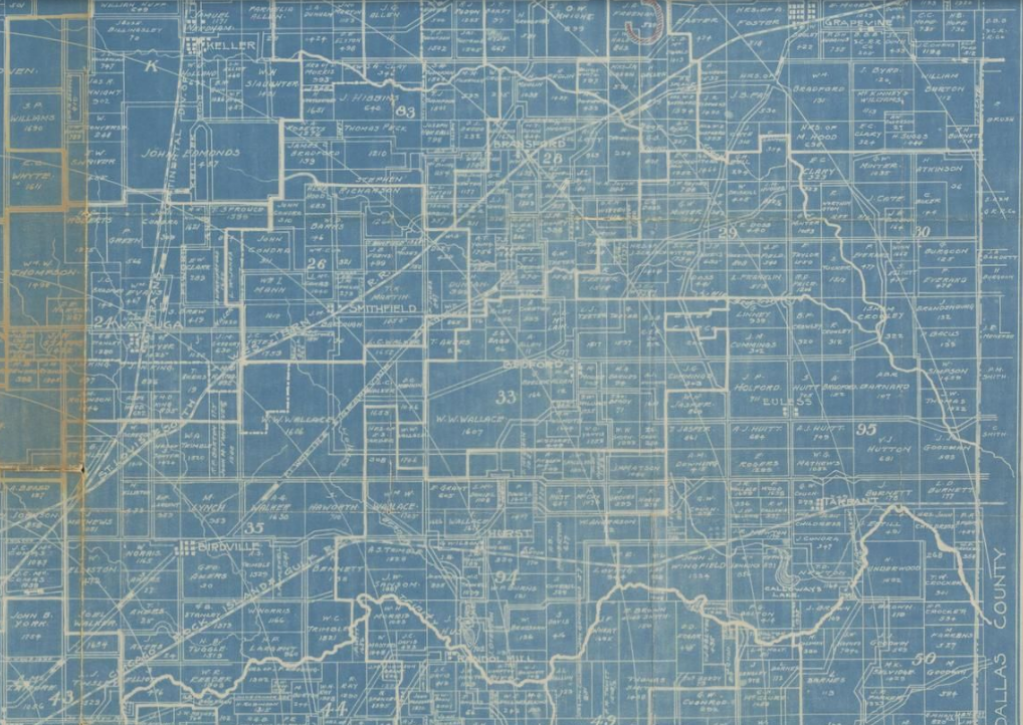
Courtesy Portal to Texas History, https://texashistory.unt.edu/ark:/67531/metapth193610/m1/1/?q=1917%20tarrant%20map.
Now that the new county road system was complete, the commissioners negotiated a one hundred dollars per month contract in April 1915 with Marion White of Grapevine to take charge of inspecting and maintaining the new county road system. Engineer Travilla had worked with White during construction and recommended him for the job. Six or seven men experienced in road work would carry on the task, equipped with a grader and scrapers for keeping the road shoulders in condition and cleaning out the ditches, as well as an oil wagon and spreader for resurfacing.
Tarrant County had attained its road-building goal, but this was not the last time road improvement would be pursued in the Grapevine area, and when the time came in the mid-1920s the road to accomplishing it would be just as bumpy.
Stay tuned . . .


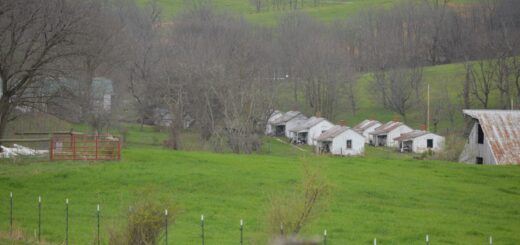
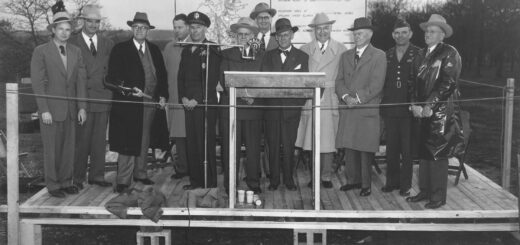
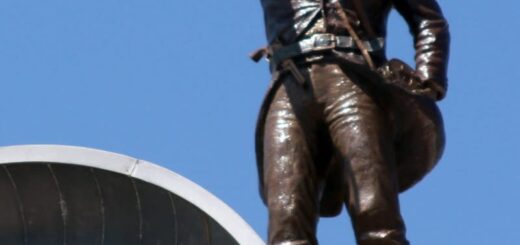
Recent Comments